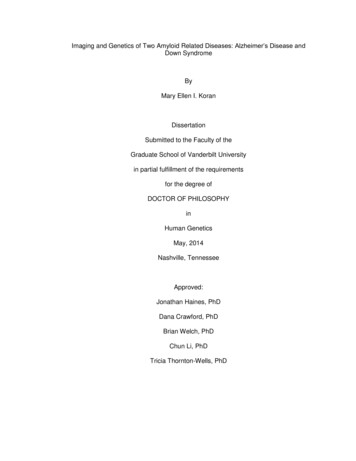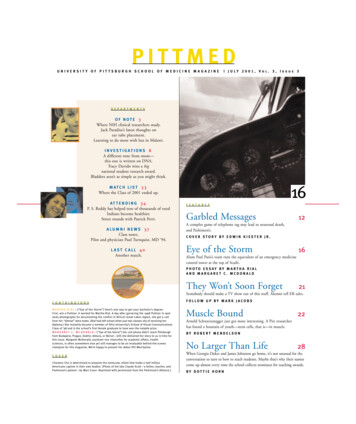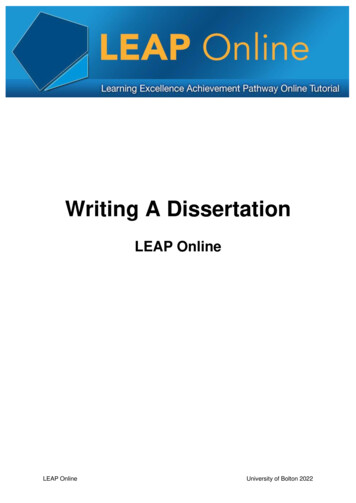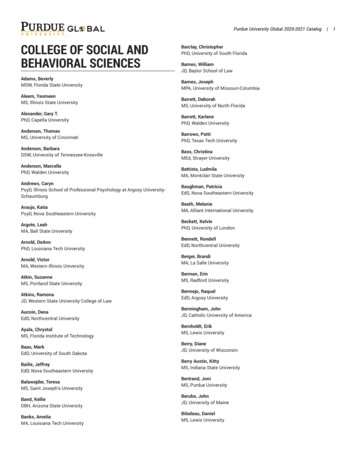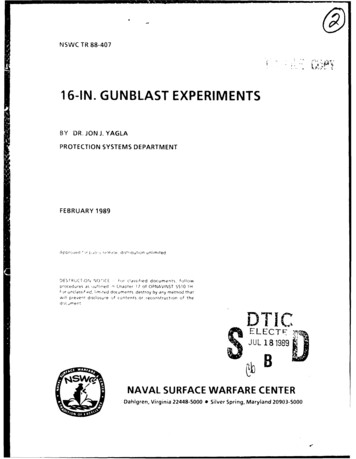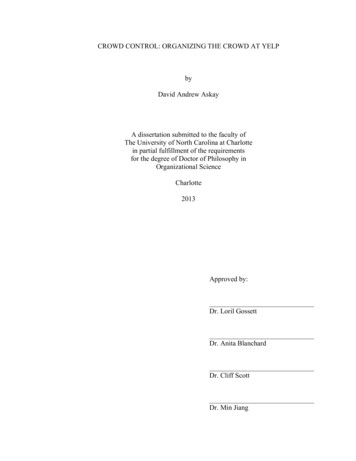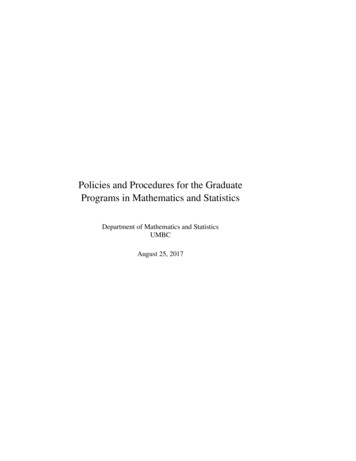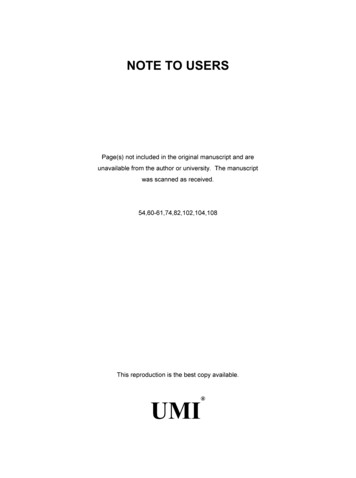
Transcription
NOTE TO USERSPage(s) not included in the original manuscript and areunavailable from the author or university. The manuscriptwas scanned as received.54,60-61,74,82,102,104,108This reproduction is the best copy available.UMI
DIGESTIVE UTILIZATION OF PHOSPHORUS IN CEREALGRAINS BY PIGSA ThesisPresented toThe Faculty of Graduate StudiesofThe University of GuelphbyYINGRAN SHENIn partial fulfillment of requirementsfor the degree ofDoctor of PhilosophyMarch, 2006 Yingran Shen, 2006
1*1Library andArchives CanadaBibliotheque etArchives CanadaPublished HeritageBranchDirection duPatrimoine de I'edition395 Wellington StreetOttawa ON K1A 0N4Canada395, rue WellingtonOttawa ON K1A 0N4CanadaYour file Votre referenceISBN: 978-0-494-20946-2Our file Notre referenceISBN: 978-0-494-20946-2NOTICE:The author has granted a non exclusive license allowing Libraryand Archives Canada to reproduce,publish, archive, preserve, conserve,communicate to the public bytelecommunication or on the Internet,loan, distribute and sell thesesworldwide, for commercial or non commercial purposes, in microform,paper, electronic and/or any otherformats.AVIS:L'auteur a accorde une licence non exclusivepermettant a la Bibliotheque et ArchivesCanada de reproduire, publier, archiver,sauvegarder, conserver, transmettre au publicpar telecommunication ou par I'lnternet, preter,distribuer et vendre des theses partout dansIe monde, a des fins commerciales ou autres,sur support microforme, papier, electroniqueet/ou autres formats.The author retains copyrightownership and moral rights inthis thesis. Neither the thesisnor substantial extracts from itmay be printed or otherwisereproduced without the author'spermission.L'auteur conserve la propriete du droit d'auteuret des droits moraux qui protege cette these.Ni la these ni des extraits substantiels decelle-ci ne doivent etre imprimes ou autrementreproduits sans son autorisation.In compliance with the CanadianPrivacy Act some supportingforms may have been removedfrom this thesis.Conformement a la loi canadiennesur la protection de la vie privee,quelques formulaires secondairesont ete enleves de cette these.While these forms may be includedin the document page count,their removal does not representany loss of content from thethesis.i*iBien que ces formulairesaient inclus dans la pagination,il n'y aura aucun contenu manquant.Canada
ABSTRACTDIGESTIVE UTILIZATION OF PHOSPHORUSIN CEREAL GRAINS BY PIGSYingran ShenUniversity of Guelph, 2006Advisor:Professor M. Z. FanThis thesis is an investigation of the digestive utilization of phosphorus (P) in majorcereal grains by pigs. Methodological aspects of measuring intrinsic phytase activity andphytate-P content in grains were studied. The results demonstrated that the intrinsicphytase hydrolysis of phytate was sample-specific and the complete removal ofphosphate groups from phytate could be achievable by microbial phytase-catalyzedhydrolysis. Multiple time point experiments need to be conducted in order to determinevalid intrinsic phytase activity, and phytate-P content measured by microbial phytasehydrolysis. The potential of barley, com, oats and wheat in providing true digestible Pfor weaned and growing pigs was measured according to the simple regression analysismethod.Pigs were fed semi-purified diets formulated from these test cereal grainingredients according to a 4 x 4 Latin square design. True P digestibility and fecalendogenous P outputs were estimated for growing pigs, although these measurementswere affected by reduced feed intake for some cereal grains in weanling pigs. True fecalP digestibility values were determined to be 64.7, 59.8, 83.5 and 41.2% for barley, com,oats and wheat, respectively. Fecal endogenous P output accounted for a significantportion of the daily P requirements in pigs. Phytate degradation associated with cerealgrain feeding contributed substantially to the digestion and absorption of P at the pre
cecal level. The large intestine did not play a significant role in the absorption of P fromthe major cereal grains in the pig. In order to understand the relative regional importanceof the apical transcellular phosphate (Pi) transport along the intestinal longitudinal axis,kinetics of sodium-Pi co-transport activity and apparent Pi diffusion were examined invitro with the fast-filtration technique by using [32P]phosphate tracer and gut mucosalapical membrane vesicles prepared by the Mg2 -precipitation and the differentialcentrifugation procedures from gut tissues collected from weaned pigs. The apical Na Pi co-transporter activity is expressed along the entire intestinal longitudinal axis in thepig. The whole gut apical Na -Pi co-transporter capacity is important to absorb luminal Pito maintain the epithelial metabolism, however, contribute little to the whole body Prequirement and homeostasis. In summary, pigs can utilize P from conventional cerealgrains with a digestive efficiency likely much higher than previously reported in theliterature.
ACKNOWLEDGEMENTSLooking back, I realize that much has changed over the years since entering myPh.D. program. Positive developments in my life are enormous, particularly in myacademic achievements and personality development. There is no doubt in my mind thatall these are with the help, guidance, encouragement and patience from my supervisor,Dr. Ming Fan. Additionally, I am grateful that I could often have thoughtful advice,timely encouragement, and significant help from my other supervisory committeemembers: Dr. Cecil Forsberg, Dr. Roger Hacker, Dr. Steve Leeson, Dr. Brian McBride,and Dr. Trevor Smith. The impact they all have on me will benefit me far beyond myPh.D. program here. I also like to thank Dr. Larry Schaeffer, Dr Hans Stein, Dr. Kees deLange, and Dr Trevor Smith for serving in my thesis defense committee.My student life with my lab family is also overwhelming. I am fortunate that Ihave my colleagues: Todd, Dale, Xiaojian, Yingxin, Tania, and Lijuan. The assistancethey provided to me during analysis, animal surgeries, statistical discussions, and eventea-time together is not only of concrete help, but also pleasant and lasting memory. Thehelp from our other lab members of Rejun, Zirong, Chenbo is also greatly appreciated.My family is simply a part of me and their help, understanding, support, andpatience are indispensable. I can’t imagine that I could foster strength without their love.I would also like to acknowledge the financial assistance to my program fromOntario Graduate Scholarship in Science and Technology (OGSST) and Mary EdmundsWilliams Scholarship. My research was made possible with the fundings from OntarioPork, Ontario Ministry of Agriculture and Food (OMAF) and the Natural Science andEngineering Research Council (NSERC) of Canada.
TABLE OF CONTENTSABSTRACTACKNOWLEDGEMENTS. iTABLE OF CONTENTS.iiLIST OF EQUATIONS. viLIST OF TABLES. viiLIST OF FIGURES. xLIST OF ABBREVIATIONS. xivCHAPTER 1GENERAL INTRODUCTION. 11.1 Phosphorus in Swine Nutrition and its Contribution to Environmental Pollution.21.2 Mechanisms of Digestive Utilization of Phosphorus in Pigs. 41.3 Homeostasis of Phosphate and Participation Factors. 151.4 Methodology for Measuring Phosphorus Bioavailability inIngredients for Pigs. 211.5 Factors Affecting Phosphorus Bioavailability. 241.6 Research Hypotheses and Objectives. 33CHAPTER 2METHODOLOGICAL ASPECTS OF MEASURING PHYTASE ACTIVITYAND PHYTATE PHOSPHORUS CONTENT IN SELECTED CEREALGRAINS AND DIGESTA AND FECES OF PIGS. 37ii
2.1. Abstract. 372.2. Introduction.382.3. Materials and Methods. 402.3.1. Principles of Determination. 402.3.2. Sources and Preparation of Samples.412.3.3. Assay Solution Preparations. 412.3.4. Enzyme Activity Assays.422.3.5. Phytate Phosphorus Recovery from Purified Sodium Phytate. 432.3.6. Phytate Phosphorus Assay for Samples. 442.3.7. Calculations and Statistical Analyses. 452.4. Results and Discussion. 472.4.1. Phytase Activity. 472.4.2. Phytate Phosphorus Content. 49CHAPTER 3TRUE PHOSPHORUS DIGESTIBILITY AND THE ENDOGENOUSPHOSPHORUS OUTPUTS ASSOCIATED WITH BARLEY FOR PIGS. 613.1. Abstract.613.2. Introduction. 623.3. Materials and Methods. 633.3.1. Animals, Diets, and Experimental Design. 633.3.2. Chemical Analyses. 65iii
3.3.3. Calculations and Statistical Analyses. 663.4. Results. 673.5. Discussion. 71CHAPTER 4TRUE PHOSPHORUS DIGESTIBILITY AND THE ENDOGENOUSPHOSPHORUS OUTPUTS ASSOCIATED WITH CORN FOR PIGS AREDETERMINED WITH THE SIMPLE LINEAR REGRESSION ANALYSISTECHNIQUE.914.1. Abstract. 914.2. Introduction. 934.3. Materials and Methods. 944.3.1. Principles of Estimation.944.3.2. Animals, Diets and Experimental Design. 954.3.3. Chemical Analyses. 974.3.4. Calculations and Statistical Analyses. 974.4. Results. 994.5. Discussion. 103CHAPTER 5TRUE PHOSPHORUS DIGESTIBILITY AND THE ENDOGENOUSPHOSPHORUS OUTPUTS ASSOCIATED WITH OAT GRAIN FORWEANLING AND GROWING PIGS DETERMINED WITH THEiv
SIMPLE LINEAR REGRESSION ANALYSIS TECHNIQUE. 1275.1. Abstract. 1275.2. Introduction. 1285.3. Materials and Methods. 1295.3.1. Animals, Diets, and Experimental Design.1295.3.2. Chemical Analyses. 1315.3.3. Calculations, and Statistical Analyses. 1325.4. Results. 1325.5. Discussion. 135CHAPTER 6TRUE PHOSPHORUS DIGESTIBILITY AND THE ENDOGENOUSPHOSPHORUS LOSSES ASSOCIATED WITH WHEAT FOR WEANLINGAND GROWING PIGS DETERMINED WITH THE REGRESSIONANALYSIS TECHNIQUE. 1576.1. Abstract.1576.2. Introduction. 1586.3. Materials and Methods. 1596.3.1. Animals, diets, and experimental design. 1596.3.2. Chemical analyses. 1606.3.3. Calculations and statistical analyses. 161
6.4. Results. 1626.5. Discussion. 166CHAPTER 7EXPRESSION OF THE APICAL SODIUM-PHOSPHATE CO-TRANSPORTERKINETICS AND CAPACITY ALONG THE INTESTINAL LONGITUDINALAXIS IN THE PIG. 1867.1. Abstract. 1867.2. Introduction.1877.3. Materials and Methods. 1897.3.1 Materials . 1897.3.2 Animals and tissue preparation. 1897.3.3 Preparation of apical membrane vesicles. 1917.3.4 Protein and enzyme assays. 1927.3.5 Uptake measurements. 1927.3.6 Calculations and statistical analyses.1937.4. Results. 1967.5. Discussion. 199CHAPTER 8GENERAL DISCUSSION AND CONCLUSIONS. 2138.1 Phytase Activity and Phytate-Phosphorus Content in Cereal Grains. 2138.2 Application of the Regression Analysis Technique. 215vi
8.3 Factors Affecting the Application of the Regression Analysis Technique. 2188.4 Phosphate Uptake along the Digestive Tract. 2208.5 General Conclusions.221LITERATURE CITED.vii225
LIST OF EQUATIONSEquationPage2.1.Y a bx ex2, if x xo.452.2.Y PI,ifx xo . 452.3.xo O.5b/c. 462.4.PI a bxo exo2 a - b2/(4c).463.1. 100% - [(Zn x P.) I (L x Pn)] x 100%. 663.2.PAl -PL [(DT / 100) x PDi]. 673.3.DTi11 D.-Al (Pv Ft/ PniDl)/ x 100%. 674.1.PAi PDixZ A. . 944.2.PE [(DTi - DAl) x PDi]/100%. 987.1./uptake7.2.JMial (((RF-RB)xS)/RI)/(WxI). 1947.3./initial (/max x STRACER)/(7xm ScOLD7.4.Kd Jdiffii / Stracer. 1957.5Rm (Pm/PH * wt) X 100 .1957.6./cap {[(Rf - Rb)*S]/Ri}/W. 193xXJmaxX60x60x24/(1000viii /liffu. 194 TRACEr)x1000)x31x. 195
LIST OF TABLESTablePage1.1.Phosphorus availability of some cereal grains for pigs. 312.1.Comparison of the analyzed contents of total and phytate phosphorus (p)and intrinsic phytase activity in selected cereal grain samples of thisstudy with the literature data. 552.2.Time course of recovery of phosphorus released from purified sodiumphytate at low and high concentrations during enzymatic hydrolysisby microbial phytase. 563.1.Composition of the experimental diets for the weaned and the growing pigs. 753.2.The apparent ileal and fecal digestibility values of dry matter (DM), andtotal phosphorus (P) and the degradability of phytate-P complex in thebarley sample as determined with the weaned and the growing pigs. 773.3.Dietary phosphorus (P) input and the partitioning of P outputs in ileal digestaand feces of the weaned and the growing pigs fed barley-based diets varyingfrom low to high in P content.793.4.Partitioning the contents of different forms of phosphorus (P) in diets, ilealdigesta and feces of the weaned and the growing pigs fed the barley-baseddiets varying in P content. 813.5.Summary and comparison of true and apparent phosphorus (P) digestibilityand availability values (%) in barley for weaned and growing pigs from thisstudy and those reported in the literature. 834.1.Composition of the experimental diets for the weaned and the growing pigs. .109ix
4.2.The apparent ileal and fecal digestibility values (%) of dry matter (DM) andtotal phosphorus (P), and degradability of phytate-P complex in com-baseddiets as determined with the weaned and the growing pigs.Ill4.3.Dietary phosphorus (P) input and the partitioning of P outputs at the ilealand the fecal levels in the weaned and the growing pigs fed com-baseddiets varying from low to high in P content. 1134.4.Partitioning the contents of different forms of phosphorus (P) in diets,ileal digesta and feces in the weaned and the growing pigs fed com-baseddiets varying in P content. 1154.5.Summary and comparison of the apparent and true phosphorus digestibilityand availability values (%) in com for the weaned and the growing pigsfrom this study and those reported in the literature. 1175.1.Composition of the experimental diets for the weaned and the growing pigs. 1405.2.The apparent ileal and fecal digestibility values of dry matter (DM) andtotal phosphorus (P) and degradability of phytate-P complex in oats andthe experimental diets as determined with the weaned and the growing pigs. 1425.3.Dietary phosphorus (P) input and the partitioning of phosphorus outputsin the ileal digesta and in the feces of the weaned and the growing pigsfed oats-based diets varying from low to high in P content. 1445.4.Dietaiy phosphorus (P) input and the partitioning of phosphorus outputs infeces of the weaned and the growing pigs fed oats-based diets varying fromlow to high in P content. 1465.5.Summary and comparison of true and apparent phosphorus digestibility andX
availability values (%) in oats for the weaned and the growing pigs fromthis study and those reported in the literature. 1516.1.Composition of the experimental diets for the weaned and the growing pigs.1696.2.The apparent ileal and fecal digestibility values of dry matter (DM) andtotal phosphorus (P), and degradability of phytate-P complex in wheat asdetermined with the weaned and growing pigs. 1716.3.Dietary phosphorus (P) input and the partitioning of P outputs in ileal digestaand feces of the weaned and the growing pigs fed wheat-based diets varyingfrom low to high in P content. 1736.4.Partitioning the contents of different forms of phosphorus (P) in diets,ileal digesta and feces of weaned and growing pigs fed wheat-based dietsvarying in P content. 1756.5.Summary and comparison of true and apparent phosphorus digestibilityand availability values (%) in wheat for weaning and growing pigs from thisstudy and those reported in the literatures. 1777.1.Physiology parameters of digesta and plasma of weaned pigs fed regularweaner diets. 2037.2.Comparison of fresh tissue weight, apical membrane marker enzyme activity,the marker enzyme enrichment, apical membrane and tissue protein contentsand the apical membrane protein recovery in the post-weaned pig. 2047.3.Kinetic parameter estimates of the sodium (Na )-phosphate co-transport intothe apical membrane vesicle prepared from the tissues collected alongthe intestinal longitudinal axis of the post-weaned pig. 206xi
7.4.Calculated tanscellular sodium (Na )-phosphate co-transport capacity formeeting daily total and available phosphorus (P) requirements in thepost-weaned pig.2078.1.Summary of analyzed nutrient values and in vivo utilization of cerealgrains by pigs. 223xii
LIST OF FIGURESFigure1.1.PageThe summarized major pathways of intestinal phosphorus (P) digestionand absorption from feed or endogenous sources in the pig. 51.2.Predominant pathways of phytate hydrolysis in both in vivo in the porcine gutand in vitro conditions. 81.3.Illustration of proposed phosphate transport mechanisms in the pig.131.4.The major routes of phosphate utilization and excretion in the pig.162.1.Time course of monitoring the amount of phosphorus (P) released fromselected cereal grain samples by intrinsic phytase hydrolysis. 572.2.Quadratic with plateau relationships between the amount of phosphorus(P) released and incubation time from selected cereal grain samplesafter enzymatic hydrolysis by microbial phytase. 592.3.Quadratic with plateau relationships between the amount of phosphorus(P) released and incubation time from digesta and fecal samples collectedfrom pigs fed com-based diets during enzymatic hydrolysis bymicrobial phytase.603.1.Relationships between the apparent ileal and fecal digestible dietaryphosphorus (P) input and the dietary total P input in the weaned and thegrowing pigs fed the barley-based diets varying from low to highin P content. 843.2.Comparison of the endogenous phosphorus (P) outputs associated with thebarley sample and true P digestibility between the ileal and the fecal levels ofxiii
the growing pigs. 863.3.Relationships between the relative contributions of the endogenousphosphorus (P) outputs in ileal digesta and feces as a percentage of thetotal dietary P content in the growing pigs and dietary P level. 873.4.Relationships between the ileal and the fecal degradable phytate phosphorus(P) and the dietary phytate P intake in the weaned and the growing pigs fedthe barley-based diets varying from low to high in phytate P content. 883.5.Degradability of phytate-P complex associated with the barley samplemeasured at the pre-cecal and the fecal levels for the weaned and thegrowing pigs.4.1.90Relationships between the apparent ileal and fecal digestible dietaryphosphorus (P) input and the dietary total P input in the weaned and thegrowing pigs fed com-based diets varying from low to high in P contents. 1194.2.Comparison of the endogenous phosphorus (P) outputs and true Pdigestibility associated with the com sample between the ileal and the fecallevels, and between the weaned and the growing pigs. 1214.3.Relationships between the relative contributions of the endogenousphosphorus (P) outputs in ileal digesta and feces as a percentage of totaldietary P contents in the weaned and the growing pigs fed com-baseddiets varying from low to high in P contents.1224.4.Linear relationships between the pre-cecal and the fecal degradablephytate phosphorus (P) inputs and the dietary phytate P input in the weanedand the growing pigs fed com-based diets varying from low to high inxiv
phytate P content. 1244.5.Degradability of phytate-P complex measured at the pre-cecal and the fecallevels for the weaned and the growing pigs. 1265.1.Relationships between the apparent ileal and fecal digestible phosphorus (P)input and the dietary total P input in the weaned and the growing pigs fedoats-based diets varying from low to high in P content. 1495.2.Comparison of the endogenous phosphorus (P) outputs and true Pdigestibility associated with the oat sample between the ileal and the fecallevels, and between the weaned and the growing pigs. 1515.3.Relationships between the relative contributions of the endogenousphosphorus (P) outputs in the ileal digesta and feces as a percentageof total dietary P content in the weaned and the growing pigs fed oats-baseddiets varying from low to high in P content. 1525.4.Linear relationships between the degradable phytate phosphorus (P)associated with the oat sample and
method. Pigs were fed semi-purified diets formulated from these test cereal grain ingredients according to a 4 x 4 Latin square design. True P digestibility and fecal endogenous P outputs were estimated for growing pigs, although these measurements were affected by reduced feed intake for some cereal grains in weanling pigs. True fecal

